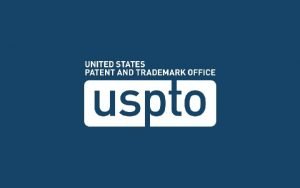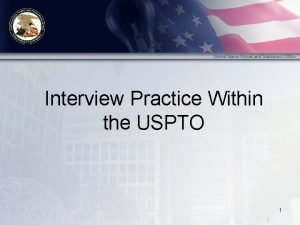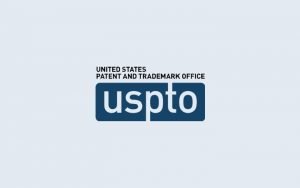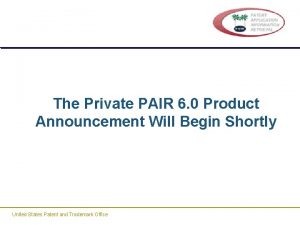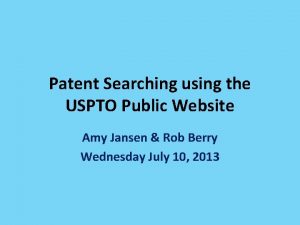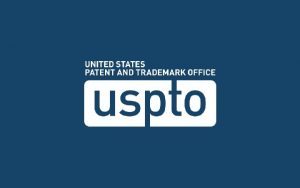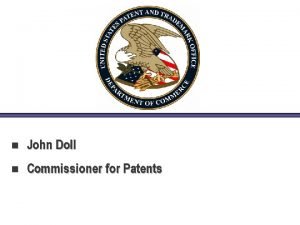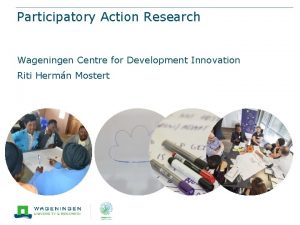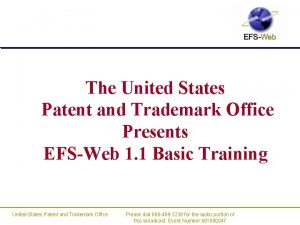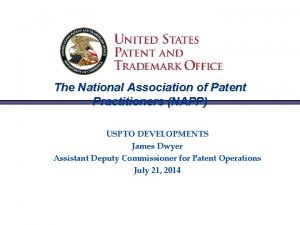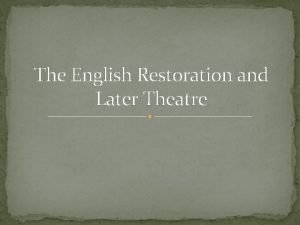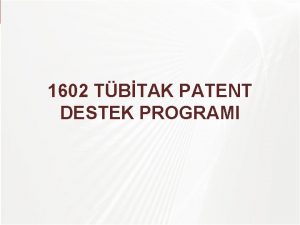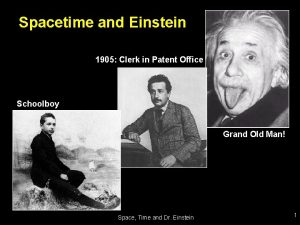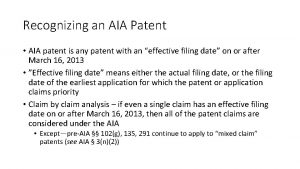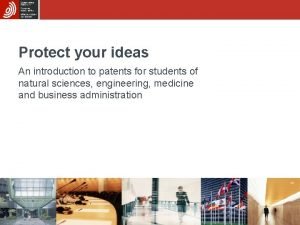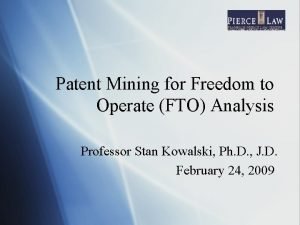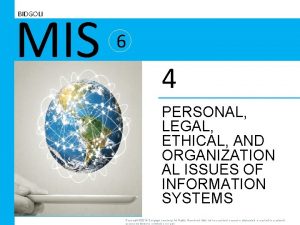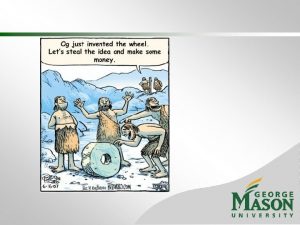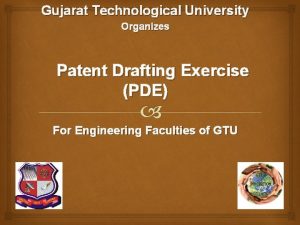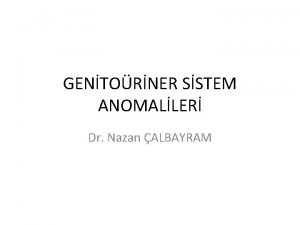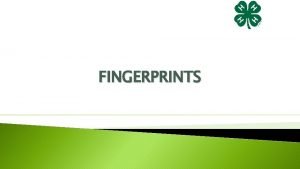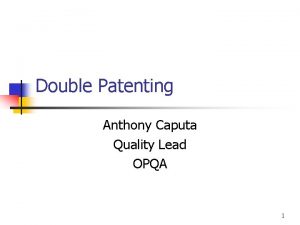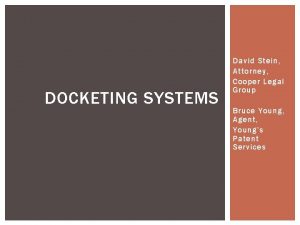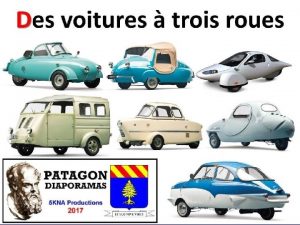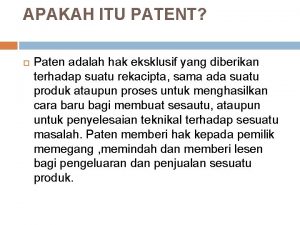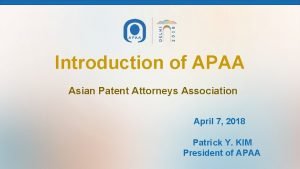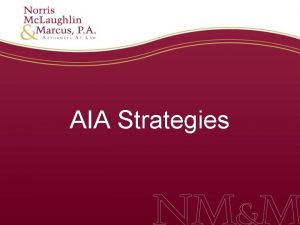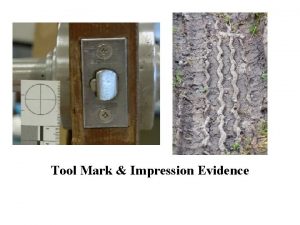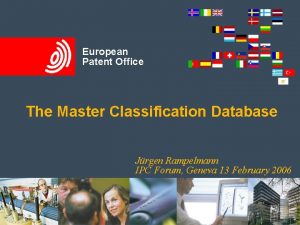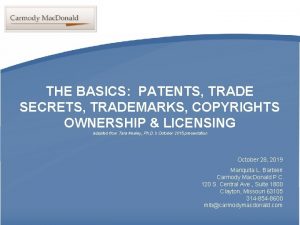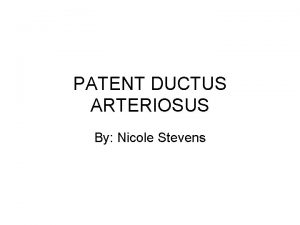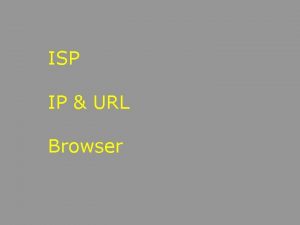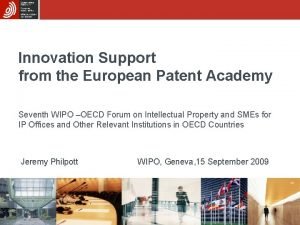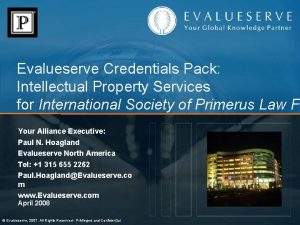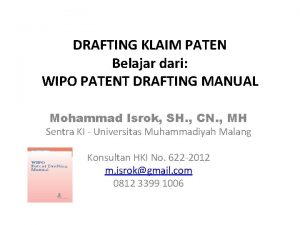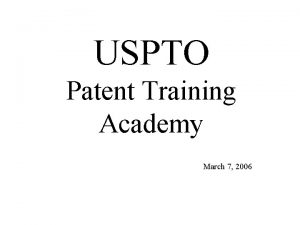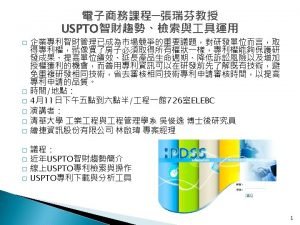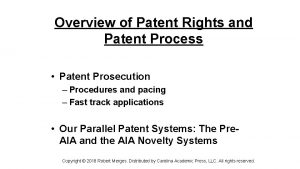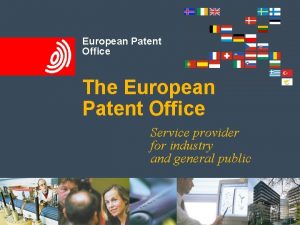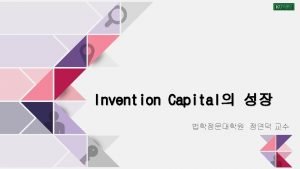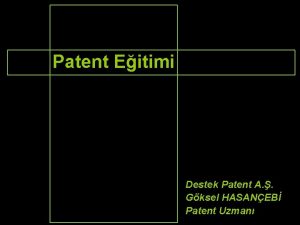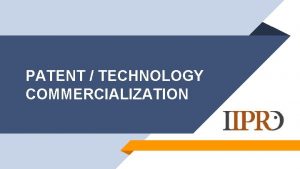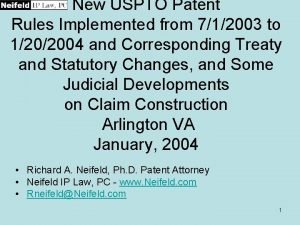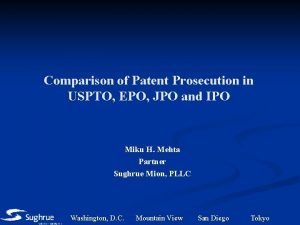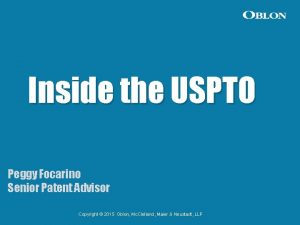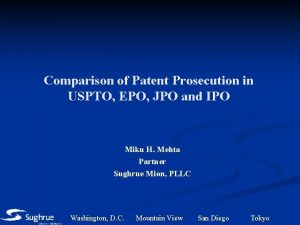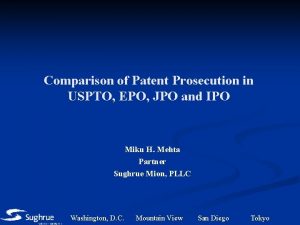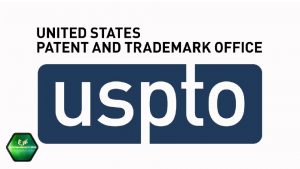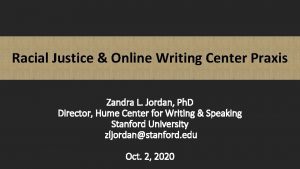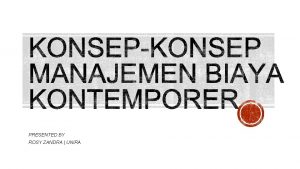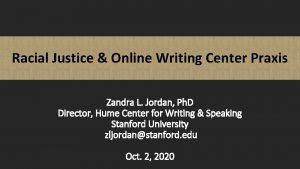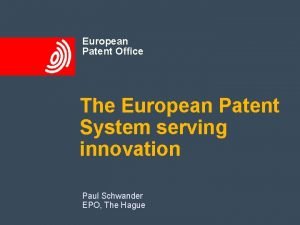USPTO Office of Innovation Development Patent Overview Zandra






























![Provisional Utility Applications Use of USPTO cover sheet [PTO/SB/16] encouraged: Provides a clear indication Provisional Utility Applications Use of USPTO cover sheet [PTO/SB/16] encouraged: Provides a clear indication](https://slidetodoc.com/presentation_image/5a10578c1b4fba5b198344c73e7d2b78/image-31.jpg)











- Slides: 42


USPTO Office of Innovation Development Patent Overview Zandra Smith Pro Se Assistance Center Coordinator

Objectives • Overview of Intellectual Property (IP) • Process of Filing a Patent Application • Resources

Overview of Intellectual Property Utility/Plant Patent Design Patent Trade Secrets Copyrights Trademarks What is protected Inventions – Process, machine, manufacture, or composition of matter Ornamental characteristics embodied in, or applied to, an article of manufacture Commercially valuable information (e. g. , formulas, techniques, processes) Art, in an allencompassing sense – original works fixed in a tangible medium Marks in commerce that indicate the source or origin of goods or services Protects Against… Making, using, selling, offering for sale, and importing into the U. S. Stealing or unauthorized disclosure Copying, performing, displaying, and creating derivative works Using a mark in a way that causes likelihood of confusion Endures until… Generally, from the patent grant date to 20 years from the earliest effective U. S. filing date 15 years from issuance of patent for applications filed on or after May 13, 2015 Publicly disclosed The life of the author + 70 years Abandoned or loss of distinctiveness or secondary meaning None Full None Rights of Independent Third Party Creators Examples Coca Cola formula

Overview of IP: Types • Trademarks – Protects marks in commerce that indicate the source or origin of goods or services – Source: Federal, State, and Common Law • Copyrights – Protects original (art) works fixed in a tangible medium – Source: U. S. Const. , Art. I, Sec. 8 • Trade Secrets – Protects commercially valuable information – Source: State and Common law • Patents – Protects inventions – Source: U. S. Const. , Art. I, Sec. 8

Overview of IP: Trademarks • Key Purposes: – Allow consumers to identify the source or producer of different products and services – helps their buying decisions – Encourage trademark owners to provide goods and services of consistent quality and to build goodwill in the trademark

Federally Registered Trademarks • Right to enforce nationally and bring legal action in federal courts • Use of federal Trademark registration symbol ® • Right to record mark with Customs • Serve as basis foreign filing • Publication in U. S. Trademark database ® ® guess the mark

Overview of IP: Registered Trademarks Word Mark: North Carolina State University Serial Number 2932440

Overview of IP: Copyright – Protects “original works of authorship” including literary, dramatic, musical, artistic and other works fixed in a tangible medium – Library of Congress administers registration; USPTO advises the Executive branch on intellectual property issues including copyright – © symbol can be used without registration

Copyright Registration • Copyright protection is secured automatically upon creation (fixation) – A work is “created” when it is fixed in a copy for the first time • No publication or registration is required – There are, however, advantages to registration

Overview of IP: Trade Secrets • Any information that derives economic value from not being generally known or ascertainable • Can be formulas, patterns, compilations, programs, devices, methods, techniques or processes • Protection stems from common law dating to the 1800’s • All states have some sort of trade secret protection • Most laws based on the Uniform Trade Secrets Act • In 2014 Congress considered, but did not pass, federal versions of the UTSA

Why are Trade Secrets useful? • Protects commercially valuable proprietary information, e. g. , formulas, recipes, or business information that gives a competitive advantage • Customer lists • Product formulations • Search algorithms • Trade Secrets are not generally known and must be subject to reasonable efforts to preserve confidentiality • No set term for protection

How to Lose a Trade Secret? • Failure to take adequate steps to prevent disclosure • Owner or owner-authorized disclosure • Reverse engineering • Independent development

Overview of IP: A Mobile Phone Trademarks: • Made by “Apple” (logo) • Product “i. Phone” • Software “i. OS", “Safari” Copyrights: • Software code • Instruction manual • Ringtone Patents: • Semiconductor circuits • Touch Screen • Battery/Power Control • Antenna • Speaker • Device Housing Trade secrets: • ? ? ? Designs (some of them patented): • Form of overall phone • Placement of button & speaker • Color pattern of trim • Surface finish © Apple

Overview of IP: What is a Patent? • A Property Right – Right to exclude others from making, using, selling, offering for sale or importing the claimed invention – Limited term – Territorial: protection only in territory that granted patent; NO world-wide patent • Government grants the property right in exchange for the disclosure of the invention

The Role of the Patent System Protect Inventions Encourage Inventions Promote commercialization and application of invention Accelerate the commercialization of invention to the whole society

What is a Patent? • A Property Right – Right to exclude others from making, using, selling, offering for sale or importing the claimed invention – Limited term – Territorial: protection only in territory that granted patent; NO world-wide patent

Why get a Patent? • A patent can: – Help to gain entry into, and deter others from entering into, a market – Attract investors – Be used as a marketing tool to promote unique aspects of a product – Be asserted against an infringer – Be used as collateral to obtain funding and increase leveraging power – Create revenue – sell or license like other property • Patents are a form of property that can add value to a company’s assets

Overview of IP: Registered Trademarks

What happens after I get my patent? • • • Licensing Enforcement More innovation and competition Administrative Trials Litigation Etc…

Patent Examination Process Overview Application is filed by Inventor or Assignee USPTO Pre-Exam Appeal Amendment and/or argument EXAMINER APPLICANT Rejection and/or objection Notice of Allowance USPTO Grants Patent Abandonment

Pre-filing Decisions • Should I file an application? – Prior art search – Business plan – who will buy the invention? • • When should I file? Where should I file? What type of application(s) to file? Who should prepare the application(s)?

Provisional Utility Applications • A low-cost way to establish an early effective filing date (priority date) with fewer formalities • A provisional application does NOT issue as a patent, but a later-filed regular application may issue as a patent and benefit from the provisional application filing date • 12 month window to file corresponding utility patent application in order to benefit from the priority date of the provisional application • Provisional application is abandoned automatically at 12 months and is not examined

Provisional Utility Applications File nonprovisional utility application US Patent Granted 12 months pass, no non-provisional is filed Abandonment Provisional Application

Provisional Utility Applications Additional benefits of Provisional Applications: • Patent term measured from filing date of subsequent non-provisional application • Patent term is currently 20 years from the date of filing • Provides up to an additional 12 months of protection on your invention based on filing of the non-provisional. • Term patent pending allowed to be applied • Inventors may use term during time period after patent application (Provisional, Non-Provisional, Design, or Plant) has been filed, but before patent has issued

Provisional Utility Applications (MPEP 201. 04(b)) • Low cost submission to establish filing date – $130 small entity – $65 micro entity • For micro entity status, each inventor (and any assigneeapplicant) certifies that he/she: – Qualifies as a small entity (less than 500 employees); – Has not been named as an inventor on more than 4 previously filed patent applications; – Did not, in calendar year preceding the calendar year in which the applicable fee is paid, have a gross income exceeding 3 times median household income; and – Has not assigned, granted, or conveyed (and is not under obligation to do so) a license or other ownership interest in the application concerned to an entity that, in calendar year preceding the calendar year in which applicable fee is paid, had a gross income exceeding 3 times the median household income.

Current USPTO Fee Schedule http: //www. uspto. gov/learning-and-resources/fees-and-payment/uspto-fee-schedule

Current USPTO Fee Schedule http: //www. uspto. gov/learning-and-resources/fees-and-payment/uspto-fee-schedule

Provisional Utility Applications (MPEP 201. 04(b)) • Automatic abandonment after one year • Inventor given time to investigate market potential / make improvements – Be careful - too much change could result in loss of provisional filing date – Many inventors file multiple provisional applications during the 1 -year pendency of the first filed provisional to include improvements • Also provide time to obtain counsel if desired • No patent issues—not examined

Provisional Utility Applications • Simplified filing requirements • Items required: 1. Specification - CLEAR DESCRIPTION - in compliance with 35 USC 112, Paragraph (a) • enablement, written description, best mode 2. Drawings (needed in almost all cases) 3. Filing fees 4. Cover Sheet identifying Provisional Application
![Provisional Utility Applications Use of USPTO cover sheet PTOSB16 encouraged Provides a clear indication Provisional Utility Applications Use of USPTO cover sheet [PTO/SB/16] encouraged: Provides a clear indication](https://slidetodoc.com/presentation_image/5a10578c1b4fba5b198344c73e7d2b78/image-31.jpg)
Provisional Utility Applications Use of USPTO cover sheet [PTO/SB/16] encouraged: Provides a clear indication that applicant is filing a provisional application. • Inventor name(s) • Inventor residence(s) • Title of the invention • Correspondence address • Attorney information (if any) • U. S. government interest (if any)

Electronic Filing Information Electronic Filing – EFS-Web Guidance and Resources http: //www. uspto. gov/patents-application-process/applying-online/efs-webguidance-and-resources EFS Sandbox http: //www. uspto. gov/ebc/portal/sandbox/efs 0 -3 -0. htm EFS – Process of filing online http: //www. uspto. gov/patents-application-process/applying-online/efs-webguidance-and-resources Fillable form – Provisional Application Cover Sheet http: //www. uspto. gov/sites/default/files/forms/Provisional. SB. pdf

Where do you go from here? Provisional Applications – As Basis for Priority • Domestic Priority – For non-provisional applications • Foreign Priority – Foreign Applications can claim benefit of Provisional Application filing date if filed within 12 months of the Provisional filing date under Paris Convention Article 4 – Patent Cooperation Treaty (PCT) application can claim priority to US Provisional Application

Tools and Resources • The Office has a number of tools and resources to help applicants throughout the patent application filing process and beyond

Manual of Patent Examining Procedure (MPEP) http: //www. uspto. gov/web/offices/pac/mpep/index. html

Inventors Assistance Center • 1 -800 -786 -9199 • Staffed by experienced former USPTO supervisors and examiners • Will answer general questions about patent examination and procedures • Can assist you in filling out patent forms

Patent Pro Bono Program • Nationwide program to assist financially under-resourced independent inventors and small businesses • Provides access to free legal assistance by registered patent attorneys

Pro Se Assistance Program Pilot program for inventors who file patent applications without the assistance of a registered patent attorney or agent – Dedicated personnel for assisting pro se applicants – In-person assistance for the general public at USPTO Headquarters – Targeted support to connect applicants with relevant resources and information – Online resources found on http: //www. uspto. gov/patentsgetting-started/using-legal-services/pro-se-assistanceprogram – Nonprovisional Utility Patent Application Checklist

Patent and Trademark Resource Centers (PTRCs) • Provides access to patent search resources – – Pub. EAST & Pub. WEST Provides information on application process and fee schedule • Offers assistance on how to do historical research patents and trademarks • Shows you a directory of local patent attorneys who are licensed to practice before the USPTO • Offers classes on intellectual property (varies by location) • Help you find assignee information and much more http: //www. uspto. gov/learning-and-resources/supportcenters/patent-and-trademark-resource-centers-ptrcs •

Regional Offices

Thank You! Office of Innovation Development innovationdevelopment@uspto. gov

 Zandra smith
Zandra smith Uspto interview questions
Uspto interview questions Uspto
Uspto Private pair uspto
Private pair uspto Uspto
Uspto Uspto
Uspto John doll uspto
John doll uspto Mysite socccd
Mysite socccd Radical vs disruptive innovation
Radical vs disruptive innovation Rdi research development innovation
Rdi research development innovation Wageningen centre for development innovation
Wageningen centre for development innovation Difference between office location and office layout
Difference between office location and office layout Patent electronic business center
Patent electronic business center National association of patent practitioners
National association of patent practitioners English royal patent of 1662
English royal patent of 1662 Tübitak patent desteği
Tübitak patent desteği Patent quality metrics
Patent quality metrics Einstein patent clerk
Einstein patent clerk Patent effective filing date
Patent effective filing date Advantages and disadvantages of patents
Advantages and disadvantages of patents Fto patent
Fto patent Mis bidgoli
Mis bidgoli Trademark and trade secret
Trademark and trade secret Patent impressions are
Patent impressions are Patent drafting exercise gtu
Patent drafting exercise gtu Meatomi
Meatomi Patent fingerprints
Patent fingerprints Patent effective filing date
Patent effective filing date Docketing systems
Docketing systems Grinnall scorpion 3
Grinnall scorpion 3 Apakah paten
Apakah paten Patent attorney newcastle
Patent attorney newcastle Asian patent attorneys association
Asian patent attorneys association Patent effective filing date
Patent effective filing date Patent impressions are
Patent impressions are Mcd in patent
Mcd in patent Nike com patent virtual marking
Nike com patent virtual marking Ductus arteriosus
Ductus arteriosus Browserb
Browserb European patent academy courses
European patent academy courses Evalueserve patent search
Evalueserve patent search Wipo patent drafting manual
Wipo patent drafting manual Truncus arterioso
Truncus arterioso
